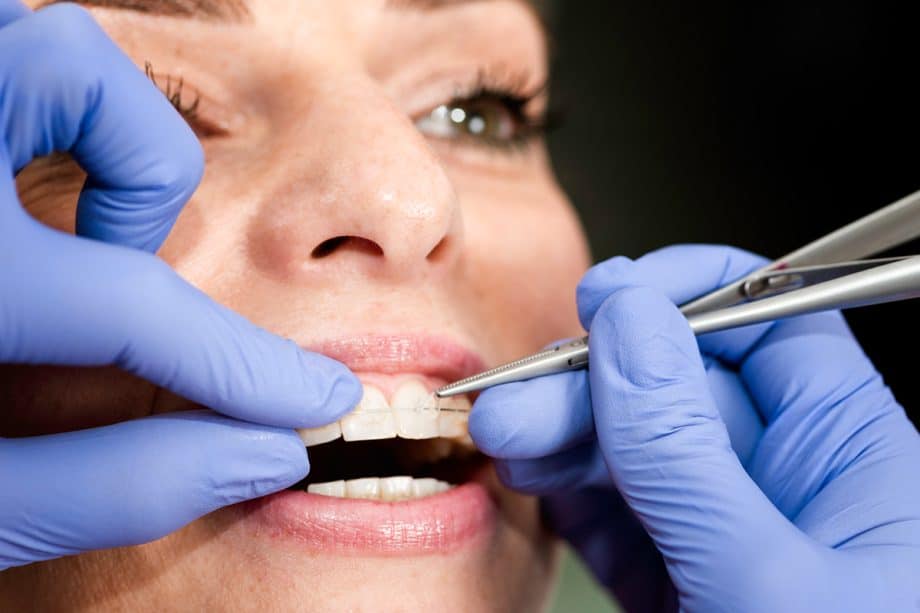Braces are versatile orthodontic appliances for children, teens, and adults. They can correct crooked, crowded, or gapped teeth and orthodontic bite issues.
Generally, braces take one to two years to complete, though the treatment time may vary depending on the complexity of the patient's case.
How Braces Work
Most traditional braces consist of four parts: brackets, archwires, bands, and elastics. The orthodontist cements the brackets to the front of each tooth, and metal bands go around each second molar. A metal archwire connects the bands and brackets, held by small elastic bands.
Conventional braces work by gradually tightening the archwire over time. As the archwire moves, the bracketed teeth move with it. The bone rebuilds behind the teeth, allowing them to stay in their new positions.
Braces move teeth horizontally and vertically and rotate them to the proper positions.
Good Candidates for Braces
- Crooked, crowded, gapped, or rotated teeth
- Misaligned dental bite (overbite, underbite, open bite, or crossbite)
- Healthy teeth and gums with no untreated tooth decay or gum disease
- Excellent oral hygiene practices
- Willingness and ability to participate in the treatment process
- Ready to wear a retainer indefinitely after treatment concludes
The Process of Getting Braces
Step 1: Consultation
During your child's consultation, your orthodontist will examine your child's teeth and evaluate any malocclusion or bite problems. They will also check on general oral health and ensure the patient's teeth and gums are healthy enough to proceed.
The orthodontist will take digital or physical impressions of the patient's teeth, establishing a baseline.
Step 2: Design
The orthodontist will plan your child's treatment and may show you a digital preview of the teeth after completion.
Step 3: Installation
During the next appointment, the dentist will cement the brackets to the teeth, place the bands on the molars, and insert the archwire. The dentist will place small elastic bands around each bracket to hold the wire and allow the teeth to move along it.
Step 4: Adjustments
Your child will visit the orthodontist for an adjustment every two to four weeks. During an orthodontic adjustment, the doctor will check progress and tighten the wire to produce the desired results.
Step 5: Removal
After one to two years on average, your orthodontist will reveal your child's new smile.
Step 6: Retainer
At first, your child will need to wear their retainer night and day. Gradually, they may be able to reduce this to wearing it at night. Dr. Hannawi-Tadros recommends wearing the retainer indefinitely to ensure the teeth stay in place.
Tips for Keeping Your Treatment on Track
Keep Teeth and Braces Sparkling Clean
When braces patients do not correctly care for their teeth, they could face a lifetime of oral health issues like tooth decay and gum disease. Ensure your child brushes and flosses according to their doctor's instructions to protect their natural smile.
Floss Properly
Tools like interproximal brushes and floss threaders can help clean under and around the wires.
Change Elastics as Prescribed
The elastic bands holding the wire and brackets will gradually loosen over time, so your child must replace them periodically.
Have Problems Repaired Immediately
If your child's bracket loosens or their wires break, ensure that you see the orthodontist as soon as possible. The longer the problem persists, the more prolonged treatment will take.
Wear Your Retainer
The retainer is vital to preserving your investment in your child's orthodontic care.
Frequently Asked Questions About Braces
Do braces hurt?
Braces may cause minor discomfort at first as the teeth adjust. Each adjustment could cause soreness, but most of the time, your child's braces will feel comfortable.
What is the right age for braces?
We recommend beginning treatment at age 11 or 12 when most permanent teeth have emerged. Children may need interceptive treatment at an earlier age. Each child should see an orthodontist by age seven to track their oral development.
Call Attleboro Pediatric Dentistry
If your child or teen needs braces, they may worry about their treatment. The process takes time and dedication, but your child will feel proud and confident in their new smile at the close of their treatment.
We would gladly schedule a consultation with Dr. Hannawi-Tadros to answer your questions. Please call our Attleboro, MA, office at 508-409-6160 to schedule your appointment today.


